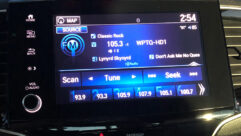I was fortunate to begin my radio career at 13 years old in the second-largest radio market in the country, Los Angeles.
Having “grown up” working at MOR, classical and talk stations, I was comfortable in a relatively conservative radio environment. But in 2000 I moved to New York to attend college, and in 2001 I started working at heritage alternative rocker WLIR(FM) in Garden City, N.Y. I began as a production assistant and later served as production director.
The environment at WLIR encouraged creativity, demanded you have fun while at work and expected nothing but the best from its staff.

Larry “The Duck” in the WLIR 92.7 studio at 175 Fulton Street, Hempstead, N.Y., in 1987. January 2014 marked the 10th anniversary of WLIR 92.7 FM leaving the dial. But that iteration of WLIR remains special in many ways … it was different … not only because it had taken a chance in 1982, flipping from an illustrious progressive rock format to an untested alternative rock presentation, but because of an intense loyalty that developed among fans and staff alike.
WLIR wasn’t just another radio station; it was a lifestyle.
In 1959 John Rieger had started WLIR in the basement of the Garden City Hotel on Long Island, originally airing a beautiful music format. In 1970, Rieger allowed two radio professionals right out of college, Richard Neer and Michael Harrison, to flip the format to progressive rock. It was at this point that WLIR started to develop an intensely loyal fan base.
In 1982, Elton Spitzer, then owner and general manager, and Denis McNamara, the program director, made the controversial decision to flip the format further from progressive rock to new wave, feeling that the market was oversaturated with album rock-oriented stations. This is where WLIR really began to earn its reputation as the station that “dares to be different.”
MOVER AND SHAKER
Originating from Hempstead and covering New York City and the tri-state area, it became a station with influence beyond its transmitter power of 1,000 watts.
With millions of potential listeners, WLIR helped advance and, in many cases, introduce such artists as U2, The Ramones, Depeche Mode, the Cure, the Clash, XTC and countless other new wave and punk bands. Programmers at stations in New York and other markets were influenced by WLIR’s willingness to take a chance on new artists before they entered the mainstream market.
McNamara, now a consultant, said, “We knew music was changing very dramatically. This really accelerated us to make a decision. Do we live in the past or do we move forward?”
In 1987, the station changed hands to The Morey Organization. With an increase in power, ’LIR continued introducing new music into the ’90s with artists such as Nirvana, Beck and Green Day, and the ’00s with artists such as Coldplay, Moby and Daft Punk.
It continued to operate with an alternative rock format until January 2004; then, receiving an offer they could not refuse, The Morey Organization sold the frequency to Univision, which flipped the format to Spanish language, leaving the WLIR listener with no alternative (pun intended).
Even 10 years after leaving the airwaves, though, you will find former WLIR listeners reminiscing about voting for Screamer of the Week, the famous Tuesday Night Concert Series, the ’LIR DJs spinning at their favorite night club and, most of all, how they felt the station was their station.
Now the questions are different. Could WLIR exist in today’s environment? How would it continue to be different?
There has been a recent resurgence in the interest of the heritage station. Not only does it continue to live and grow online, but Hollywood has stepped into the picture with an upcoming documentary about “The station that dares.”

Screenshot of the WLIR.FM homepageWLIR.FM
There’s no question that most radio stations today have a tight play list.
Facebook, Myspace, Amazon and iTunes are great for finding music that you have already heard elsewhere. However, there are few sources that curate new music for the listener.
It was because of this perceived void that former 92.7 staffer Bob Wilson started www.wlir.fm in 2005. With many of the former air-staff helping to contribute to the website, Wilson began streaming the music he could no longer find on the FM dial. However, when he started to receive email requests and his number of listeners started to grow online, Wilson recognized that there was still an unmet demand not only for the heritage music of the station but for new music, as well.
WLIR.FM keeps the successful formula of the familiar disk jockeys voice-tracked throughout the day, ticket giveaways, WLIR.FM bumper stickers and answering listener requests.
Wilson is careful not to make his station an oldies station playing only the heritage ’LIR music. “It is important for the station to keep moving forward,” Wilson said. “The ’LIR listener is someone who always wanted to hear new music.”
But the question remains: Can you make money with WLIR — or any format — online?
Wilson, who has just started to see the books turn black by selling banner ads and commercials on the stream, says having an interactive website is key. “Give people reasons to keep returning to your site.”
Posting links to YouTube and Facebook navigate people away from what you are doing. Forming partnerships with other websites like www.donyc.com creates the ability to have an up-to-date concert calendar on WLIR.FM. Weekly concert, show, event and merchandise contesting, as well as a WLIR.FM store, help keep the listener engaged.
“Know your audience,” Wilson emphasizes. Recognizing that WLIR.FM has a niche format, it is important to target businesses that appeal to his listeners, most of which are in the tri-state area. Concert promoters such as Live Nation and Bowery Presents, appeal to the WLIR.FM listener. Ski resorts and Broadway shows are among other advertisers that buy time on the station.

WLIR Airline Club card circa 1980. It was used by listeners to take advantage of special discounts at local stores — more evidence of the station’s “lifestyle” effect. Wilson’s goal ultimately is to get WLIR — or, more accurately, his own modernized version of WLIR — back on the FM dial; he is partnering with investors and hopes the station may return to the airwaves one day.
John Rieger is deceased. RJ Morey and Elton Spitzer are retired and could not be reached for comment for this story. They are not involved in the online station.
THE MOVIE
Interest in preserving the importance of WLIR lives, not just online but, also on-screen.
“Dare to Be Different —The Movie” is a documentary in production and set to debut at film festivals in 2015.
Focusing on the importance of WLIR to the new wave, punk and alternative rock bands of the 1980s, creator and producer Ellen Reiss Goldfarb hopes to create national awareness of the once-popular Long Island station and to demonstrate how exciting radio can be.
Having interviewed many recording artists for the film, Goldfarb says most of them feel that radio has changed for the worse and that the days of taking chances on new music are over.
“WLIR was able to break so much ground by being able to take risks on bands that people never heard of, and the fans [of the radio station] really helped this process,” Goldfarb says. “It’s almost like the magic is gone, and it would be great to get that back.”
The continued interest in WLIR is exciting to see. To find so much passion for a station that hasn’t existed in more than 10 years is impressive.
The special bond made between WLIR and its listeners accounted for much of its success. Finding a staff that connects and encourages participation from the audience, as WLIR did, is what makes a radio station truly special. That form of broadcasting is rare in today’s marketplace.
Some will argue that the music set WLIR apart from the rest. Others will say the talent propelled WLIR. The true meaning of WLIR was — and is — to take chances, to listen to your audience, and always “Dare to Be Different.”
David Plotkin is the director of production and creative services for WINS(AM) in New York.












